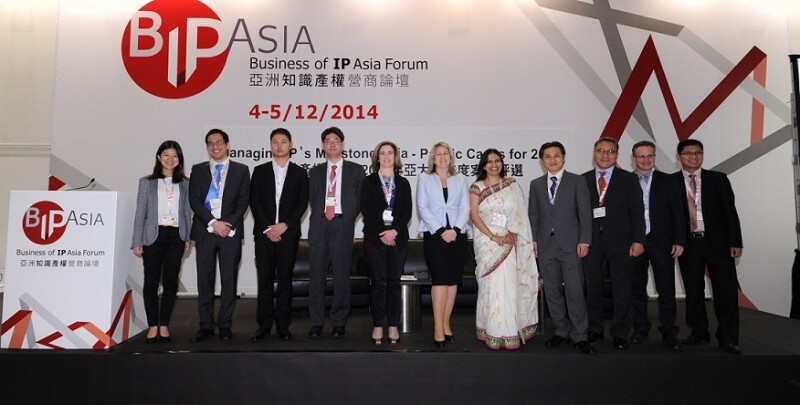
|
From L-R: Stephy Tang (Managing IP), Peter Leung (Managing IP), Mike Hu (Tencent), Takanori Abe (Abe & Partners), Rebecca Allsopp (Sanofi-Aventis Australia), Lisa Taliadoros (Jones Day), Archana Shanker (Anand & Anand), Owen Gee (inCompass IP), Gangliang Qiao (Danaher China), Thomas Treutler (Tilleke & Gibbins) and Loc Xuan Le (T&G Law Firm) |
Most of the winning parties had representatives in attendance to receive their awards and discuss the impact of each case.
India: Aloys Wobben v Enercon India
The case of Aloys Wobben v Enercon before the India Supreme Court clarified laws regarding how defendants can attack a patent’s validity. The case involved two former business partners (Aloys Wobben, an inventor, had granted his patents to Enercon Gmbh, who worked with a separate entity Enercon India). After the relationship broke down, Aloys Wobben sued Enercon Gmbh for violating its patents.
The case changed a feature of the India patent system that had frustrated rights holders. Before this decision, potential defendants had three different ways to challenge the validity of a patent. A party can pursue a Section 25(2) post-grant opposition action before the patent office within one year of grant, or a revocation action before the IP Appellate Board (IPAB) pursuant to Section 64(1). Section 64(1) also provides that if the party is sued for patent infringement before the High Court, it may counterclaim for revocation. Thus, a defendant can have up to three tries at invalidating a patent.
The Supreme Court put an end to this practice. Analysing the language of the statute as well as principle of res judicata, the court held that a defendant must select one method to challenge the patent’s validity. Thus, if a defendant raised and failed in its validity challenge before the IPAB, it can no longer raise a counterclaim in an action before the court.
Anand & Anand represented Aloys Wobben.
|
|
"For us, it’s not about damages- it’s really about sending a strong message to the market that we attach great importance to our IP protection " |
|
|
Mainland China: Tencent v Qihoo
The winning case from China was not an intellectual property case, but one of particular interest to IP owners. The decision in the Tencent v Qihoo 360 from the Supreme People’s Court is an important decision applying China’s Anti-Monopoly Law (AML), a law that is increasingly affecting IP owners. In this case, Qihoo and Tencent, both internet and technology companies, had been involved in a dispute eventually resulting in Tencent making its popular QQ instant messaging software incompatible with Qihoo’s security program. Qihoo brought suit in the Guangdong High Court alleging that Tencent’s actions violated the AML. The Guangdong High Court disagreed, and Qihoo appealed to the Supreme People’s Court.
The SPC sided with Tencent. Though it touched on several interesting issues, what was most notable was its ruling on the issue of market dominance. The court noted that though Tencent’s QQ had more than 50% of the instant messaging market, this was not sufficient to find that Tencent had market dominance, a condition that would subject it to stricter restrictions. Instead, the court found that because of various issues, such as the unique business models involved (such as the fact that Tencent’s software is free to use but makes money through other means such as advertisements). Furthermore, other aspects, such as the fact that there were other competitive players in the market and that it was relatively easy for new market entrants, led the court to rule that Tencent did not have market dominance.
Hong Kong: SNE Engineering v Hsin Chong Construction
Hong Kong’s case of the year involved a patent dispute between two construction companies who had been working on the much ballyhooed but controversial Hong Kong high-speed rail connection to mainland China. One of the few patent disputes in Hong Kong, the case clarified the law on sufficiency as well as the novelty standard for Hong Kong’s short term patent, which is similar to a utility model patent.
The parties in the case were all contractors and subcontractors responsible for clearing the path of the tunnel to be built for the rail line. Hsin Chong Construction, the main contractor, subcontracted to SNE Engineering the task of extracting old building piles from the ground. SNE in turn subcontracted Chim Kee Machinery to provide and operate the machinery. After the project started, SNE took out a short term patent on the technique.
In September 2012, Hsin Chong terminated the sub-contract with SNE, claiming that the project was progressing too slowly. It then directly engaged Chim Kee to continue with the pile extraction. SNE brought this infringement suit against both Hsin Chong and Chim Kee, who in turn asserted that the patent lacked novelty and insufficiently described the invention.
The High Court sided with Hsin Chong and Chim Kee, finding that the patent failed to sufficiently disclose the invention. Also, it found that the invention lacked novelty because SNE used the technology before filing the patent in public with little to no attempts to keep it hidden. In fact, the court noted that an individual standing next to the construction site and observing the extraction process would know more about the covered invention than reading the patent.
Hsin Chong was represented by Wong & Lawyers, with inCompass IP acting as technical adviser. Tsui & Co acted for Chim Kee.
Southeast Asia: Videojet Technologies v Nam Trinh (Vietnam)
The winning case from Southeast Asia highlights the importance of long-term enforcement strategies for brand owners. Much like the plaintiffs in the cases from India and Hong Kong, Videojet and Nam Trinh were former business partners, with Nam Trinh acting as a distributor for Videojet products. After the relationship ended, Videojet discovered through its customers that Nam Trinh continued to sell Videojet products as well as counterfeit products. The company initiated administrative actions against Nam Trinh, resulting in raids seizing the fake products. However, the company also instituted a successful civil action. Using the administrative action as a means to gather evidence, Videojet were able to get damages for not only lost profits, but also for the costs of enforcing its intellectual property, including the costs and legal fees incurred in both the administrative action and the civil case.
Gangliang Qiao, vice president and general counsel for Danaher China, the corporate parent of Videojet, says that multinationals doing business in markets such as Vietnam or China need to be willing to boldly defend their rights, even if a simple cost benefit analysis of damages versus costs may not strongly support taking action: ”At the end of the day, in terms of the damages, it’s not really what a company like Danaher is after; it’s really about sending a strong message to the market that we attach great importance to our IP protection and that we want to leave no stone unturned to protect our rights.”
Tilleke & Gibbins and T&G Law Firm represented Videojet in this matter.
Australia: Apotex v Sanofi-Aventis
The winning case from Australia dealt with an issue of importance to pharmaceutical companies around the world. In Apotex v Sanofi-Aventis, the Australian High Court ruled on whether methods of treatment involving the use of known substances are patentable. Though several lower courts had ruled that methods of treatment were patentable, the issue had never reached the High Court.
Apotex v Sanofi-Aventis involves Sanofi’s patent on the use of leflunomide to treat psoriasis. The patent on leflunomide itself expired in 2004. Generic manufacturer Apotex applied for market approval for a generic version of leflunomide and Sanofi sued on the grounds that it would violate the patent for the treatment of psoriasis. Apotex raised several arguments, including challenging the validity of the patent. Sanofi prevailed in both the Federal Court and the Full Federal Court. On appeal to the High Court, Apotex argued that treatment of human bodies was “non-economic”, thus failing the manner of manufacture test for patentability. The High Court disagreed, though several judges in dicta expressed reservations about whether other methods of treatment, such as surgical methods. The court also ruled that though Sanofi’s patent was valid, Apotex did not infringe as its product information and marketing materials indicated that the drug was not to be used for the means covered by the patent.
Jones Day represented Sanofi-Aventis.
North Asia: Apple v Samsung (Japan)
The case out of North Asia involved Japan’s first FRAND dispute in the Apple v Samsung case, where Samsung alleged that Apple violated its standards essential patents (SEPs). The Tokyo District Court ruled that several of Apple's products fell within the scope of a Samsung patent that was essential to a 3G data transmission standard (UTMS). However, it also found that Samsung violated its FRAND obligations in refusing to provide a basis for its rate demands during licensing negotiations. The court thus refused to grant an injunction, which is almost automatic when there is a finding of patent infringement in Japan.
On appeal, the IP High Court also adopted a unique approach in dealing with the case, requesting third parties to file amicus curiae-style briefs with the court on the issue of injunctions based on SEPs. While amicus briefs are common in jurisdictions such as the United States, this was the first time that they were used in a patent case in Japan and perhaps any type of legal dispute at all.
The IP High Court returned a decision finding that Samsung was entitled to damages even though its claim was based on an SEP, so long as the damages were limited by Samsung's FRAND obligations. It however, noted that Apple was a willing licenser, and thus an injunction was inappropriate.
Morrison & Foerster represented Apple.









